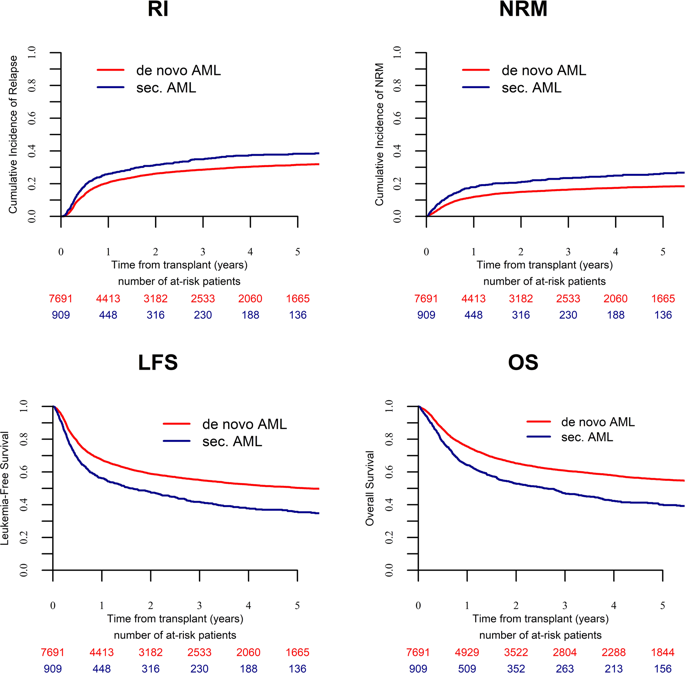当前位置:
X-MOL 学术
›
Blood Cancer J.
›
论文详情
Our official English website, www.x-mol.net, welcomes your
feedback! (Note: you will need to create a separate account there.)
Inferior outcome of allogeneic stem cell transplantation for secondary acute myeloid leukemia in first complete remission as compared to de novo acute myeloid leukemia.
Blood Cancer Journal ( IF 12.9 ) Pub Date : 2020-03-03 , DOI: 10.1038/s41408-020-0296-3 Ann-Kristin Schmaelter 1 , Myriam Labopin 2, 3 , Gerard Socié 4 , Maija Itälä-Remes 5 , Didier Blaise 6 , Ibrahim Yakoub-Agha 7 , Edouard Forcade 8 , Jan Cornelissen 9 , Arnold Ganser 10 , Dietrich Beelen 11 , Hélène Labussière-Wallet 12 , Jakob Passweg 13 , Bipin N Savani 14 , Christoph Schmid 1 , Arnon Nagler 3, 15 , Mohamad Mohty 2
Blood Cancer Journal ( IF 12.9 ) Pub Date : 2020-03-03 , DOI: 10.1038/s41408-020-0296-3 Ann-Kristin Schmaelter 1 , Myriam Labopin 2, 3 , Gerard Socié 4 , Maija Itälä-Remes 5 , Didier Blaise 6 , Ibrahim Yakoub-Agha 7 , Edouard Forcade 8 , Jan Cornelissen 9 , Arnold Ganser 10 , Dietrich Beelen 11 , Hélène Labussière-Wallet 12 , Jakob Passweg 13 , Bipin N Savani 14 , Christoph Schmid 1 , Arnon Nagler 3, 15 , Mohamad Mohty 2
Affiliation

|
Following chemotherapy, secondary acute myeloid leukemia (sAML), occurring after antecedent hematologic diseases, previous chemotherapy or radiation, has an inferior prognosis compared with de novo AML. To define the outcome of sAML in the context of allogeneic stem cell transplantation (alloSCT), a retrospective, registry-based comparison was performed, including 11,439 patients with de novo and 1325 with sAML. Among transplants in first complete remission (CR1) (n = 8,600), the 3-year cumulative incidence of relapse (RI) and non-relapse mortality (NRM) was 28.5% and 16.4% for de novo, and 35% and 23.4% for sAML. Three-year overall survival (OS), leukemia-free survival (LFS) and Graft-versus-Host Disease/relapse-free survival (GRFS) was 60.8%, 55.1%, and 38.6% for de novo, and 46.7%, 41.6%, and 28.4% for sAML, respectively. In multivariate analysis, sAML was associated with a lower OS (HR = 1.33 [95% CI = 1.21-1.48]; p < 10-5), LFS (HR = 1.32 [95% CI = 1.19-1.45]; p < 10-5) and GRFS (HR = 1.2 [95% CI = 1.1-1.31]; p < 10-4) and higher NRM (HR = 1.37 [95% CI = 1.17-1.59]; p < 10-4) and RI (HR = 1.27 [95% CI = 1.12-1.44]; p < 10-3). Results of the Cox model were confirmed in a matched-pair analysis. In contrast, results did not differ between de novo and sAML after alloSCT in induction failure or relapse. Hence, this analysis identified sAML as an independent risk factor for outcome after alloSCT in CR1.
中文翻译:

与新发急性髓细胞性白血病相比,异基因干细胞移植在继发急性髓性白血病中首次完全缓解的效果较差。
化疗后,继发于血液系统疾病,先前的化疗或放疗后发生的继发性急性髓细胞性白血病(sAML)与从头AML相比预后较差。为了定义同种异体干细胞移植(alloSCT)背景下sAML的结果,进行了一项基于注册表的回顾性比较,其中包括11,439例从新患者和1325例sAML。在首次完全缓解(CR1)(n = 8,600)的移植物中,从头开始的3年累积复发率(RI)和非复发死亡率(NRM)分别为28.5%和16.4%,分别为35%和23.4%用于sAML。从头开始的三年总生存期(OS),无白血病生存期(LFS)和移植物抗宿主病/无复发生存期(GRFS)分别为60.8%,55.1%和38.6%,以及46.7%,41.6 sAML分别为%和28.4%。在多变量分析中,sAML与较低的OS(HR = 1.33 [95%CI = 1.21-1.48]; p <10-5),LFS(HR = 1.32 [95%CI = 1.19-1.45]; p <10 -5)和GRFS(HR = 1.2 [95%CI = 1.1-1.31]; p <10-4)和更高的NRM(HR = 1.37 [95%CI = 1.17-1.59]; p <10-4)和RI (HR = 1.27 [95%CI = 1.12-1.44]; p <10-3)。Cox模型的结果在配对分析中得到确认。相比之下,alloSCT后在诱导失败或复发中从头开始和sAML的结果没有差异。因此,此分析将sAML视为CR1中alloSCT后结果的独立危险因素。10-4)和RI(HR = 1.27 [95%CI = 1.12-1.44]; p <10-3)。Cox模型的结果在配对分析中得到确认。相比之下,alloSCT后在诱导失败或复发中从头开始和sAML的结果没有差异。因此,该分析将sAML作为CR1的alloSCT后预后的独立危险因素。10-4)和RI(HR = 1.27 [95%CI = 1.12-1.44]; p <10-3)。Cox模型的结果在配对分析中得到确认。相比之下,alloSCT后在诱导失败或复发中从头开始和sAML的结果没有差异。因此,此分析将sAML视为CR1中alloSCT后结果的独立危险因素。
更新日期:2020-04-24
中文翻译:

与新发急性髓细胞性白血病相比,异基因干细胞移植在继发急性髓性白血病中首次完全缓解的效果较差。
化疗后,继发于血液系统疾病,先前的化疗或放疗后发生的继发性急性髓细胞性白血病(sAML)与从头AML相比预后较差。为了定义同种异体干细胞移植(alloSCT)背景下sAML的结果,进行了一项基于注册表的回顾性比较,其中包括11,439例从新患者和1325例sAML。在首次完全缓解(CR1)(n = 8,600)的移植物中,从头开始的3年累积复发率(RI)和非复发死亡率(NRM)分别为28.5%和16.4%,分别为35%和23.4%用于sAML。从头开始的三年总生存期(OS),无白血病生存期(LFS)和移植物抗宿主病/无复发生存期(GRFS)分别为60.8%,55.1%和38.6%,以及46.7%,41.6 sAML分别为%和28.4%。在多变量分析中,sAML与较低的OS(HR = 1.33 [95%CI = 1.21-1.48]; p <10-5),LFS(HR = 1.32 [95%CI = 1.19-1.45]; p <10 -5)和GRFS(HR = 1.2 [95%CI = 1.1-1.31]; p <10-4)和更高的NRM(HR = 1.37 [95%CI = 1.17-1.59]; p <10-4)和RI (HR = 1.27 [95%CI = 1.12-1.44]; p <10-3)。Cox模型的结果在配对分析中得到确认。相比之下,alloSCT后在诱导失败或复发中从头开始和sAML的结果没有差异。因此,此分析将sAML视为CR1中alloSCT后结果的独立危险因素。10-4)和RI(HR = 1.27 [95%CI = 1.12-1.44]; p <10-3)。Cox模型的结果在配对分析中得到确认。相比之下,alloSCT后在诱导失败或复发中从头开始和sAML的结果没有差异。因此,该分析将sAML作为CR1的alloSCT后预后的独立危险因素。10-4)和RI(HR = 1.27 [95%CI = 1.12-1.44]; p <10-3)。Cox模型的结果在配对分析中得到确认。相比之下,alloSCT后在诱导失败或复发中从头开始和sAML的结果没有差异。因此,此分析将sAML视为CR1中alloSCT后结果的独立危险因素。











































 京公网安备 11010802027423号
京公网安备 11010802027423号